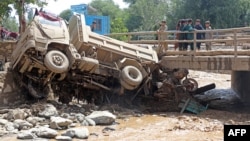
Welcome to The Azadi Briefing, an RFE/RL newsletter that unpacks the key issues in Afghanistan. To subscribe, click here.
I'm Abubakar Siddique, senior correspondent at RFE/RL's Radio Azadi. Here's what I've been tracking and what I'm keeping an eye on in the days ahead.
The Key Issue
Flash floods caused by spring downpours have wreaked havoc in most provinces in Afghanistan.
The Taliban said at least 103 people were killed and over 60 injured in floods and heavy rains between March 21 and April 29.
The downpours have also damaged thousands of houses, while over 100,000 acres of farmland have been destroyed.
“Snow and hail have ruined my apricot, apple, and cherry trees,” Sayed Gul Badshah, a farmer in the central province of Maidan Wardak, told RFE/RL’s Radio Azadi.
Saed Akbar, a farmer in eastern Nangarhar Province, said heavy rain and hail have "utterly wrecked" his wheat and vegetable crops.
In the northern Faryab Province, farmer Abdul Qureshi said floods "washed away" scores of houses in the district of Pashtun Kot.
After a prolonged dry spell in autumn and winter, Afghanistan and its neighbors have been witnessing unusually heavy rains and snowfall in the spring.
Why It's Important: Afghanistan is one of the most vulnerable countries to climate change.
Experts say climate change has worsened the frequency and severity of extreme weather events -- from droughts and heat waves to floods and storms – around the world.
Afghanistan’s ability to adapt and difficulties in attracting international aid under the unrecognized Taliban government are seen as major obstacles to dealing with the situation.
Extreme weather conditions have exacerbated the humanitarian crisis in Afghanistan, the world’s largest.
What's Next: There are signs that the international community is responding to the crisis by empowering local Afghan communities to combat climate change.
But it is unclear if the initiatives will help mitigate against large-scale natural disasters caused in part by climate change.
Deadly floods and extreme drought in recent years have uprooted millions of Afghans, some of whom have been forced to flee abroad.
What To Keep An Eye On
Reporters Without Borders (RSF) has expressed alarm about the situation of scores of exiled Afghan journalists who are staying in neighboring Pakistan.
Celia Mercier, head of RSF's South Asia desk, on April 30 urged the Pakistani authorities and international community to help protect Afghan journalists who fled their homeland for fear of retribution by the Taliban.
Mercier told Radio Azadi that Afghan journalists living in Pakistan “should be able to utilize their journalistic skills” or be allowed to move to a third country willing to host them.
Most of the nearly 200 journalists fled after the Taliban’s return to power in 2021 and are now waiting to be relocated to Western countries.
RSF said that the journalists lack access to education, health care, and employment.
Mohammad Idris Sadat, one of the stranded journalists, said many are suffering from "mental health problems because they face uncertainty" as their immigration cases are taking too long.
Why It's Important: After returning to power, the Taliban has attempted to erase the once vibrant Afghan media landscape.
Fear of reprisals by the group has forced hundreds of reporters and media workers to flee the country. Those remaining have faced beatings, arrests, and harassment.
Hundreds of print and electronic media outlets have been either shut down by the Taliban or closed due to a lack of funding.
That's all from me for now.
I'm off next week. The next Azadi Briefing will appear on May 17.
Don't forget to send me any questions, comments, or tips that you have. You can always reach us at azadi.english@rferl.org
Until next time,
Abubakar Siddique
If you enjoyed this briefing and don't want to miss the next edition, subscribe here. It will be sent to your inbox every Friday.






